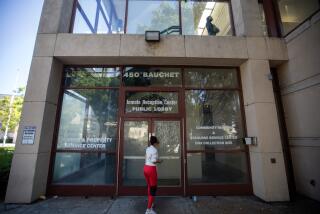3 Treated in Gas Leak at Hughes Aircraft
- Share via
Hughes Aircraft Co. workers rigged a makeshift device and safely burned off gas that remained from a leak that caused a small explosion and fire at the firm’s Newport Beach plant Tuesday morning.
Three Hughes employees who were in the basement room where the leak occurred were treated and released at Hoag Memorial Hospital Presbyterian after complaining of “burning in the eyes” and tightness in the chest, a hospital spokeswoman said. Silane gas, which burns on contact with air and causes respiratory irritation, is used in the production of silicon chips, a Hughes spokesman said.
In an unrelated incident, the complex was blacked out for almost an hour Tuesday evening. About 100 workers were evacuated while firefighters and Hughes’ employees, wearing anti-gas suits and oxygen masks, worked to restore power, which returned at 7:25 p.m.
The power outage resulted from a fire that started in a “processing machine” in the same building as the gas leak, said Battalion Chief Tom Arnold of the Newport Beach Fire Department. The fire set off sprinklers in the basement near an electrical panel, and the electricity was shut off as a security measure, he said.
An undetermined quantity of silane leaked when a valve used to control its flow was opened at about 9 a.m. Tuesday, Newport Beach Fire Capt. Al Schmell said. The gas burned through a fiberglass pipe and exploded in the room before pumps pushing it through the system were stopped, trapping the remaining silane in a 45-foot section of three-inch copper pipe, he said.
“A bottle (of silane) was being installed and a valve was inadvertently left open,” Hughes spokesman Bill Herman said.
Two maintenance employees, Terry Tobias and Roy Jacques, and security guard Paul Gutierrez, who helped extinguish the blaze, were treated at Hoag. They were released a short time later with no apparent ill effects, Newport Beach paramedic Mike Miller said.
H. J. McCarrick, an equipment engineering supervisor who was in the room at the time of the blast, refused treatment.
While firefighters stood by, Hughes workers rigged a device to pump nitrogen into the pipe containing the remaining gas, allowing it to burn up in other pipes containing air.
Shortly after noon, two Hughes workers entered the room and stationed themselves behind a panel. One held a fire extinguisher while the other threw a switch that sent the nitrogen rushing through the makeshift system.
In less than a minute, the gas was burned off and the incident was over.
More to Read
Sign up for Essential California
The most important California stories and recommendations in your inbox every morning.
You may occasionally receive promotional content from the Los Angeles Times.













